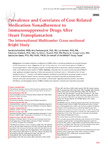Mostrar o rexistro simple do ítem
Prevalence and correlates of cost-related medication nonadherence to immunosuppressive drugs after heart transplantation: the international multicenter cross-sectional bright study
| dc.contributor.author | Schönfeld, Sandra | |
| dc.contributor.author | Denhaerynck, Kris | |
| dc.contributor.author | Berben, Lut | |
| dc.contributor.author | Dobbels, Fabienne | |
| dc.contributor.author | Russell, Cynthia L. | |
| dc.contributor.author | Crespo-Leiro, María Generosa | |
| dc.contributor.author | De Geest, Sabina | |
| dc.date.accessioned | 2022-02-08T12:13:23Z | |
| dc.date.available | 2022-02-08T12:13:23Z | |
| dc.date.issued | 2020 | |
| dc.identifier.citation | Schöndel S, Denhaerynck K, Berben L, Dobbels F, Russell CL, Crespo-Leiro MG, et al. Prevalence and correlates of cost-related medication nonadherence to immunosuppressive drugs after heart transplantation: the international multicenter cross-sectional bright study. J Cardiovasc Nurs. 2020;35(6):519-529 | es_ES |
| dc.identifier.issn | 0889-4655 | |
| dc.identifier.uri | http://hdl.handle.net/2183/29708 | |
| dc.description.abstract | [Abstract] Background: Cost-related medication nonadherence (CRMNA) refers to not taking medications as prescribed because of difficulties paying for them. Objectives: The aims of this study were (1) to assess the prevalence of CRMNA to immunosuppressants in heart transplant recipients internationally and (2) to determine multilevel correlates (patient, center, and healthcare system levels) of CRMNA. Methods: Using data from the cross-sectional international BRIGHT study, applying multistaged sampling, CRMNA was assessed via 3 self-report items in 1365 patients from 36 heart transplant centers in 11 countries. Cost-related medication nonadherence was defined as any positive answer on any of the 3 items. Healthcare system-level (ie, insurance coverage, out-of-pocket expenditures) and patient-level (ie, intention, perceived financial burden, cost as a barrier, a health belief regarding medication benefits, cost-related self-efficacy, and demographic factors) CRMNA correlates were assessed. Correlates were examined using mixed logistic regression analysis. Results: Across all study countries, CRMNA had an average prevalence of 2.6% (range, 0% [Switzerland/Brazil] to 9.8% [Australia]) and was positively related to being single (odds ratio, 2.29; 95% confidence interval, 1.17-4.47), perceived financial burden (odds ratio, 2.15; 95% confidence interval, 1.55-2.99), and cost as a barrier (odds ratio, 2.60; 95% confidence interval, 1.66-4.07). Four protective factors were identified: white ethnicity (odds ratio, 0.37; 95% confidence interval, 0.19-0.74), intention to adhere (odds ratio, 0.44; 95% confidence interval, 0.31-0.63), self-efficacy (odds ratio, 0.54; 95% confidence interval, 0.43-0.67), and belief about medication benefit (odds ratio, 0.70; 95% confidence interval, 0.57-0.87). Regarding variability, 81.3% was explained at the patient level; 13.8%, at the center level; and 4.8%, at the country level. Conclusion: In heart transplant recipients, the CRMNA prevalence varies across countries but is lower than in other chronically ill populations. Identified patient-level correlates are novel (ie, intention to adhere, cost-related barriers, and cost-related self-efficacy) and indicate patient-perceived medication cost burden. | es_ES |
| dc.language.iso | eng | es_ES |
| dc.publisher | Wolters Kluwer | es_ES |
| dc.relation.uri | https://doi.org/10.1097/JCN.0000000000000683 | es_ES |
| dc.rights | Atribución-NoComercial-SinDerivadas 3.0 España | es_ES |
| dc.rights.uri | http://creativecommons.org/licenses/by-nc-nd/3.0/es/ | * |
| dc.subject | Healthcare costs | es_ES |
| dc.subject | Heart transplantation | es_ES |
| dc.subject | Medication adherence | es_ES |
| dc.subject | Multilevel correlates | es_ES |
| dc.title | Prevalence and correlates of cost-related medication nonadherence to immunosuppressive drugs after heart transplantation: the international multicenter cross-sectional bright study | es_ES |
| dc.type | info:eu-repo/semantics/article | es_ES |
| dc.rights.access | info:eu-repo/semantics/openAccess | es_ES |
| UDC.journalTitle | Journal of Cardiovascular Nursing | es_ES |
| UDC.volume | 35 | es_ES |
| UDC.issue | 6 | es_ES |
| UDC.startPage | 519 | es_ES |
| UDC.endPage | 529 | es_ES |
Ficheiros no ítem
Este ítem aparece na(s) seguinte(s) colección(s)
-
INIBIC-ICATC - Artigos [156]






